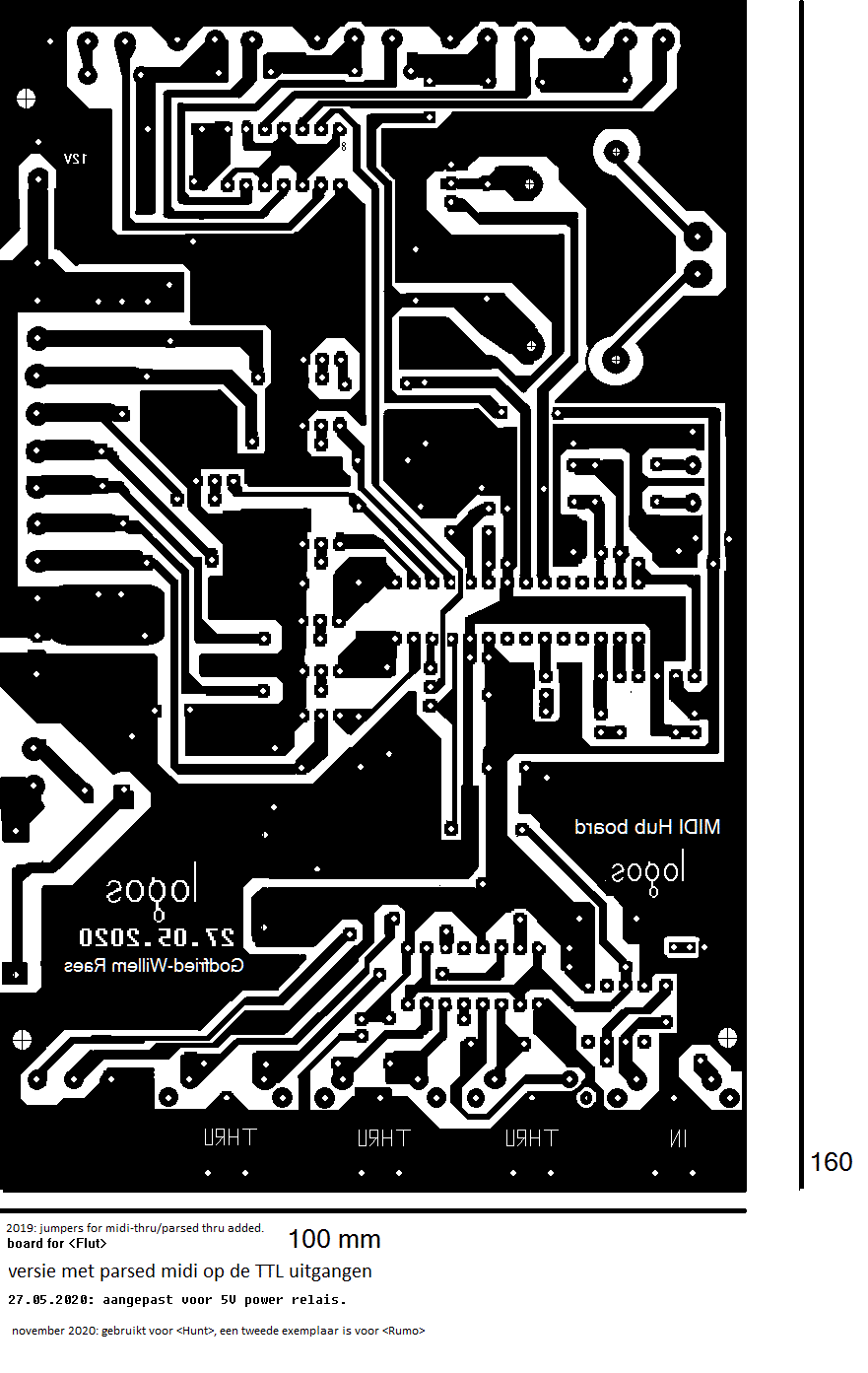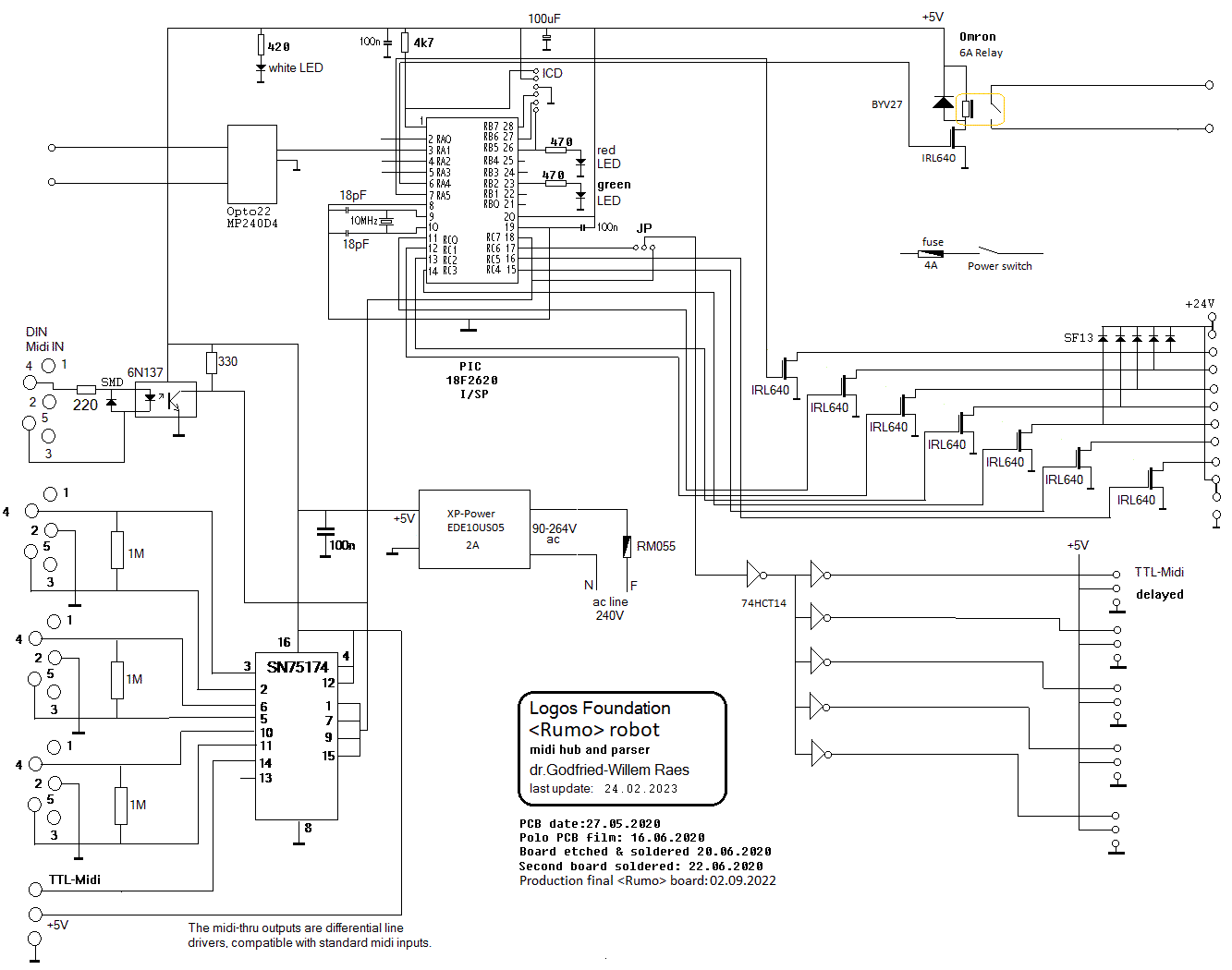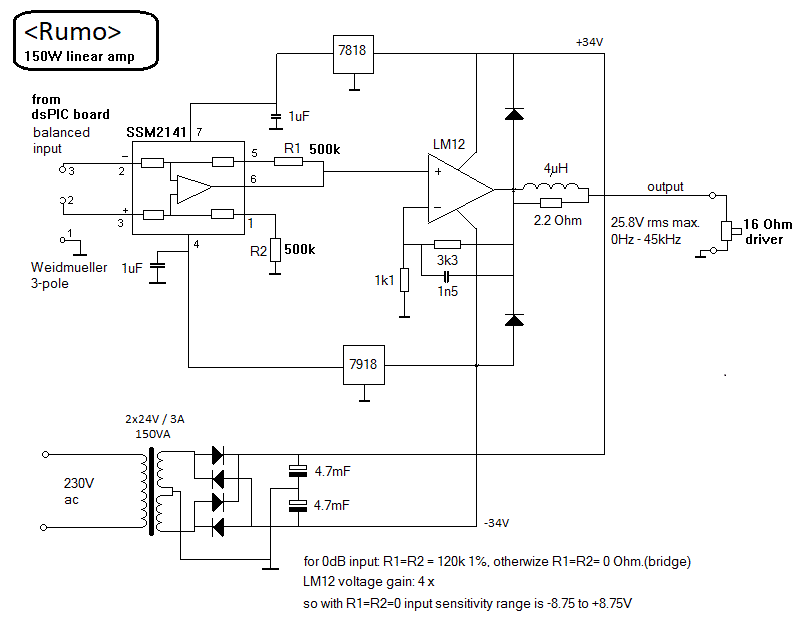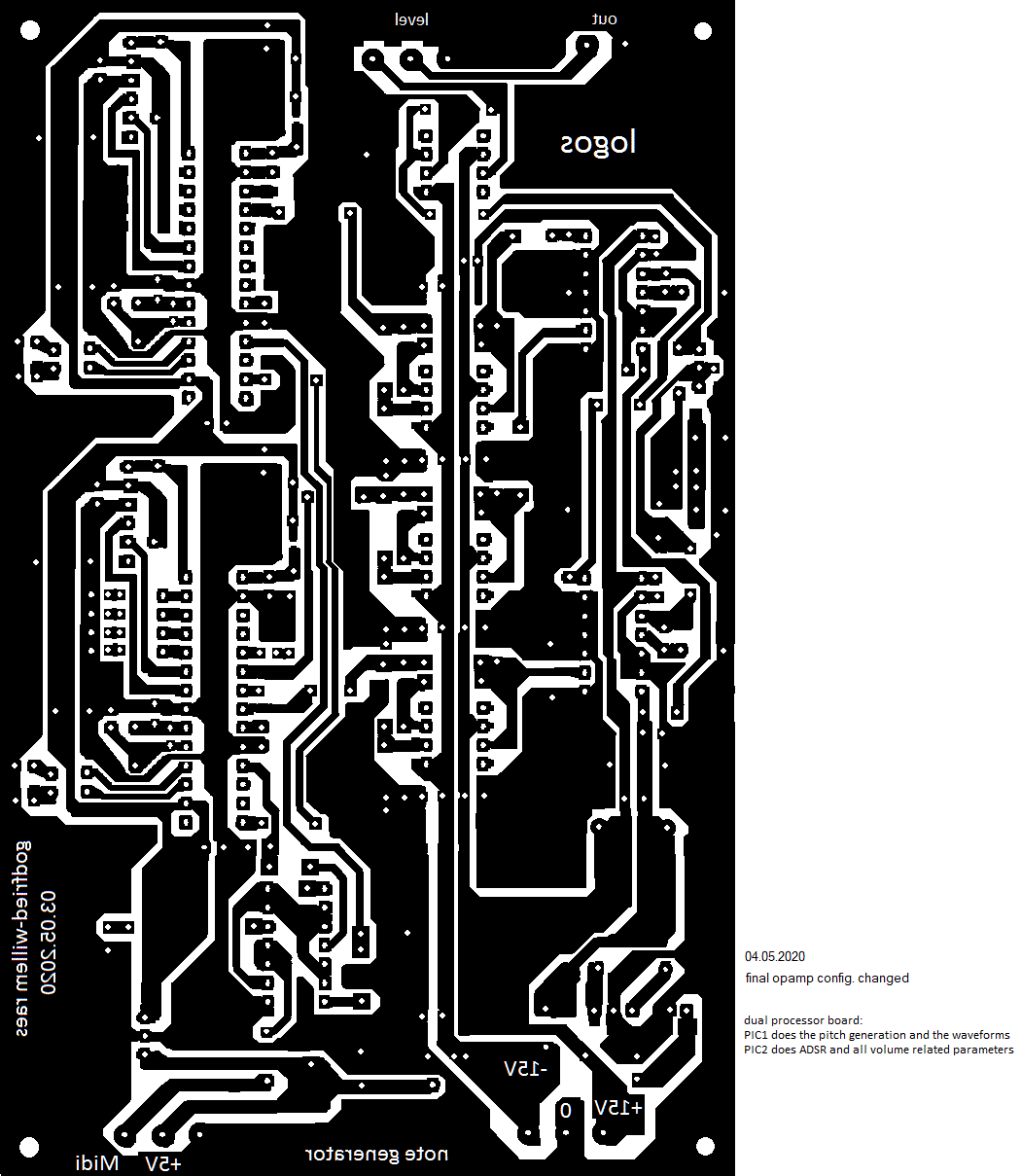|
Logos Foundation
Flanders Robotics
|
|
<Bakla>
an automated bass clarinet
Godfried-Willem RAES
2021- ...?
Version 1.0
|
<Bakla>
Tuning:
The clarinet was automated using the same mechanism as developed earlier for
robots such as <Horny>, <So> and <Autosax>. Thus it uses a
membrane compressor and an acoustic impedance convertor with a capillary to
drive the air column into resonance.
The diapason can be selected again, using controller 20. By default the clarinet
plays in equal temperament with a diapason set to A = 440Hz.
Excitation:
Acoustic researchers for a long time have been looking into methods to capture
the source of the vibration in wind instrument mouth pieces. Practical methods
to measure and record the vibration of lips or reeds on wind instruments directly,
never lead to convincing results, as the transducers required for measurement
influence normal sound production to a great extend. Hence our idea to derive
the vibration of the excitation source indirectly. A now verified method to
generate the required wave-form lookup tables for driving the membrane compressor
coupled to the impedance convertor we developed and tested thoroughly in 2020
for robots such as <Flut>, <Autosax>, <So>, <Hunt> and
now also <Bakla> consists of the following steps:
1. Excite the membrane compressor with a waveform (at least 4 periods are required
and these must be looped in the firmware) corresponding to what you would like
the robot to sound like. Lets call it WavIn(). This waveform must be without
any modulation and recorded in an anechoic chamber using high quality microphones
at a distance not larger than the size of the sound source. This signal can
best be derived from a recording of the instrument, played in the traditional
way. So, it should be recorded prior to modifications required to build the
actual robotic instrument. Make sure you record sound samples for a large series
of different notes in different dynamics and registers as excitation waveforms
differ greatly in function of these parameters.
2.- Record the sound of the robot, using a high quality condenser microphone,
with this excitation and convert it to a format suitable for the microprocessor
selected. Lets call this waveform WavOut() . Make sure the sizes of WavIN()
and WavOut() are the same and take care to align the phase as well as possible.
Normalization is also required. This is a quite tedious job, in particular for
instruments where the contribution of the instrument to the sound result is
relatively small as compared to that of the playing style, the mouthpiece etc.
For the saxophone this is noticeably the case, whereas we had less problems
in this respect with the oboe and the flute. The clarinet comes in somewhere
in-between.
3.- Calculate the required excitation waveform as: WavEx() = (2 * WavIn())
- WavOut(), in the time domain. Normalize this wave and remove any DC components.
This wave now is a model of the excitation wave deprived from the influence
of the instrument. Of course this cannot be fully true, as it doesn't take into
account the mutual coupling of excitation and instrument. However, the model
does work quite well on practical robots if enough waves are prepared to cover
the different registers and dynamic levels.
4.- Reprogram the microprocessor to use WavEx() as an excitation waveform for
as many notes and dynamics as the microprocessor can cope with.
This method was also applied in the construction of the
<Flut> and version 3 of the <So> robot
in 2020. Of course, the procedure ought to be performed for a note in each register
the instrument is supposed to sound. It would be ideal -but tedious- to follow
this procedure for each individual note. However, the microprocessor used should
than have a very large memory. The 16 bit 24EP256MC202 type used for the <Bakla>
robot, is limited to 32kBytes, enough for a maximum of 20 wavetables, 1024 bytes
each. Note that with the standard sampling rate of 44.1kS/s, the highest note
wherefore our method can be applied is midi note 64 (329 Hz). With the much
higher sampling rate of 192 kS/s it ought to be possible to calculate lookup
tables useful for notes up to 90 (1480 Hz).
The theory behind this approach is that the excitation-wave should correspond
as much as possible with the vibration of the lips or reeds that cause the vibration
in the instrument. As it is nearly impossible to capture this vibration by direct
methods, we reason that the sound produced by the instrument is the sum of the
excitation and whatever the instrument adds (or omits) to it. Thus, by sending
a sample of the normally produced sound to the membrane compressor, we should
get the excitation wave plus twofold the contribution of the instrument. By
calculation of WavEx() = (2 * WavIn()) - WavOut() we get a model of the excitation
wave. When studying and analyzing waveforms produced by real instruments, you
will notice that in fact no two periods are the same, neither in shape, neither
in length. That's why we take a minimum of four full periods. Do not use more
than say 16 periods though, because it may introduce subharmonics, if not even
rhythmical pulsation in the sound on long sustained notes. With four periods,
you get a very soft subharmonic two octaves below the sounding pitch. For this
reason we always add a tiny amount of jitter to the sampling rate. In theory
it should be a Gaussean, but in practice straight random jitter over a narrow
range leeds to very acceptable results. No two periods have exactly the same
length, just as in humanly played wind instruments.
Construction:
This bass clarinet can move slowly up and down. It is mounted on a 3-wheel
base.
Midi implementation and mapping:
The midi channel <Bakla> listens to is X (If counting from 1, this would
be channel 3).
Lights:
note 120:
note 121:
note 122:
note 123:
note 124:
note 125:.
note 126-127: not yet mounted lights, reserved for future uses.
Controllers:
#1: controller 1: Wind noise in the sound of the clarinet [default setting
48]
#3: controller 3: Vibrato depth for the horn [default setting 8]
#4: controller 4: vibrato speed for the horn [default setting 94]
#5: controller 5: tremolo depth (amplitude modulation) for the horn [default
setting 4]
#6: controller 6: tremolo speed for the horn. [default setting 20]
#7: controller 7: volume control - global volume controller for the horn.[default
setting: ]
#15: controller 15 - ADSR time scaling for the horn [default setting: 114]
#16: controller 16 - attack time controller for the horn [default setting: 32]
#17: controller 17 - attack level controller [default setting 127]
#18: controller 18 - decay time controller [default setting 91]
#19: controller 19 - release time controller for the horn (release time can
also be controlled with the release byte of a note-0ff command)[default setting
100]
The interdepencies for the controllers 7, 15, 16, 17, 18 and 19 are shown in
the graph below:

#20: controller 20 - tuning for the clarinet. By default equal temperament
and A = 440 Hz for value 64.
#40: This controller selects the waveform lookup for the register 41 to 52.
Possible values are 0 to 6. Default value is 6.
#41: This controller selects the waveform lookup for the register 53 to 70.
Possible values are 0 to 6. Default value is 5.
#42: This controller selects the waveform lookup for the register 71 to 81.
Possible values are 0 to 6. Default value is 5.
#43: This controller selects the waveform lookup for the register 82 to 91.
Possible values are 0 to 6. Default value is 2.
#66: Power on / off. This command also resets all controllers to their default
cold-boot values. Power on recalibrates the horn and brings it back to a central
position.
#69: Enable or disable automation of the lights. Default value : > 0, ON.
To switch this off, send controller with value = 0.
#80: Dynamic range controller. Default is 32 for 30 dB dynamic range.
#123: All notes off
pitch bend: range 1 semitone (-50 to + 50 cents) [note that pitch-bend must
follow a note-on].
| |
subject to changes during the building process |
|
Technical specifications:
- sizes:
- weight: 45 kg (first estimate)
- power: <100 Watt / 230 V
- tuning: A = 440 Hz (programmable)
- Ambitus:
- Loudness level: 42 - 107 dBA spl.
- Insurance value: 25.000 Euro (first estimate)
Design and construction: dr.Godfried-Willem
Raes (2020- ...?)
Collaborators on the construction of this robot:
- Kristof Lauwers
- Bert Vandekerckhove
Music composed for <Bakla>:
none so far
This robot is projected to be ready by the end of 2025, if Godfried's health
permits and if we can get some subsidy again to continue our research.
Construction diary:
15.02.2020: First sketches and designs.
Maintenance information:
Last update: 2024-03-05
by Godfried-Willem Raes
Further reading on this topic (some in dutch):
Technical data sheet, design calculations and maintenance instructions:
- HUB-board: PCB

Circuit drawing for the midi HUB board: 
PIC firmware for the HUB board: Source code
HEX-Dump. Wiring lay-out for the MIDI-hub
board:
- Amplifier for the hunting horn driver:

The PCB for this amplifier was made in 1991, when we made a series of some
20 power amps.
- Circuit for the membrane compressor:
- PCB for the membrane compressor drawn above:
 This
version is more or less the same as the board used for <Autosax> V5.0,
but has minor improvements.
This
version is more or less the same as the board used for <Autosax> V5.0,
but has minor improvements.
- Here is a picture of the assembled PCB:

References:
- Beauchamp, J.W., "Analysis of Simultaneous Mouthpiece and Output Waveforms
of Wind Instruments" . In: j-aes, 1980, Preprint No. 1626,
- Benade, Arthur .H., "Fundamentals of Musical Acoustics". Ed.:
Oxford University Press, 1976.
- Lembke, Sven-Amin e.o., "The role of spectral-envelope characteristics
in perceptual blending of wind-instrument sounds" In: Acta Acustica,Vol
101, p.1039-1051, Montreal, 2015.
- Raes, Godfried-Willem, "Kursus Akoestiek", Ghent University College
1982/2014, Internet: http://www.logosfoundation.org/kursus/4023.html
[zie ook de hoofdstukken over stemmingen: /kursus/index.html]:
- Raes, Godfried-Willem
"Stemmingen en Temperamenten" (2011) [pdf]
- Raes, Godfried-Willem, "Expression
control in musical automatons", 1977/2023,
- Raes, Godfried-Willem, "Logos @ 50, het kloppend hart van de avant-gardemuziek
in Vlaanderen", ed. Stichting Kunstboek, Oostkamp, 2018.





 This
version is more or less the same as the board used for <Autosax> V5.0,
but has minor improvements.
This
version is more or less the same as the board used for <Autosax> V5.0,
but has minor improvements.